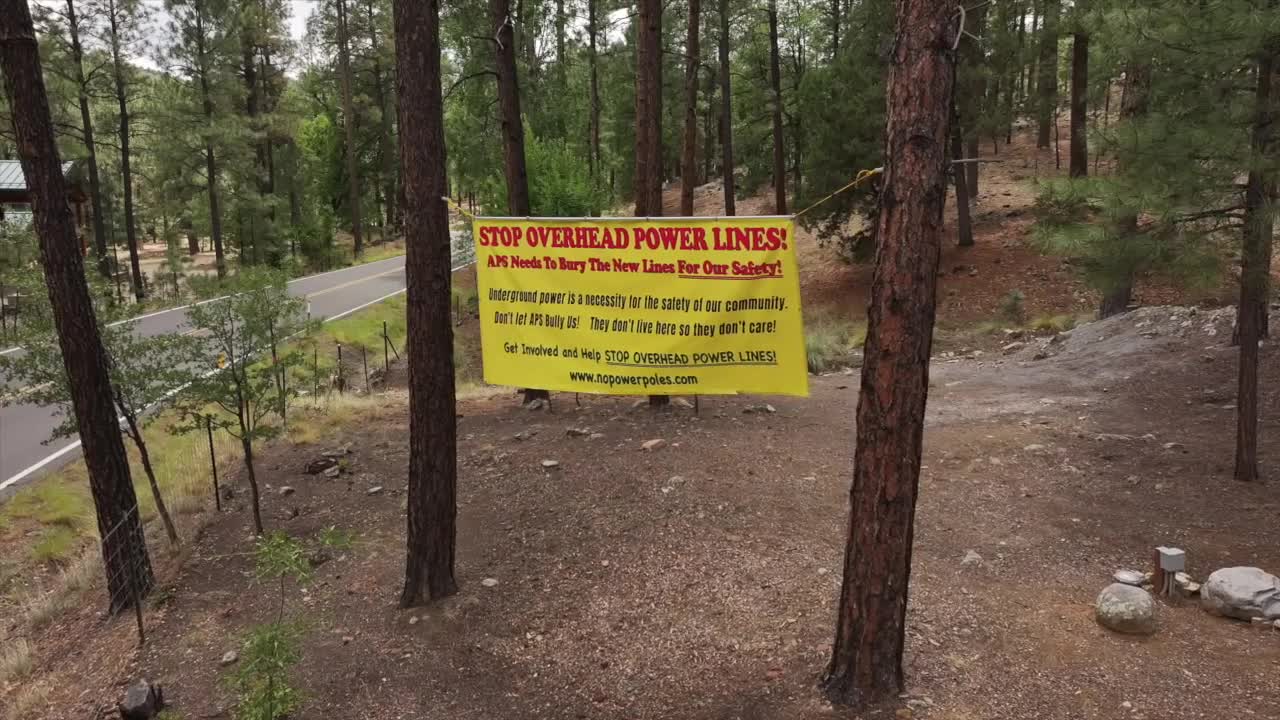WALKER, AZ — They build their dream homes in the pines south of Prescott, and now a power company wants to put utility poles near their front yards.
“We feel like we're being steamrolled right now, and nobody's listening to us,” said Rob Croswhite. He is one of several neighbors rallying together in this unincorporated area to protect their views, their safety, and their peace of mind.
“We love the environment, with the trees and the mountains,” said Croswhite, who has called the area home for nearly five years. “We built everything here and basically built our dream home.”
But his view is now at risk.

Instead of looking at beautiful pine trees – the reason he and his wife bought the property – he would see power poles and power lines. Arizona Public Service (APS) plans to install overhead power lines along the road right in front of his house and other homes in what is called the Walker Road Upgrade.
He said he was told he could lose as many as nine or 10 trees, including possibly a 100-year-old heritage apple tree.
But the issue runs deeper than ruined views. Homeowners worry about fire safety and want the lines buried underground so they can’t spark wildfires.
“I myself have lost a lot of sleep,” he said. “And I know other people have also.”

APS says the new lines would replace old ones to the west that are over a century old. Under the plan, APS would remove 4.4 miles of existing line in the middle of the forest along rugged terrain. The current power lines are difficult to access, making maintenance challenging, said Frank Sanderson, APS’s northern district director.
It would be replaced with seven miles of overhead power lines along Walker Road. The new line would be placed on weathered steel poles up to 60 feet tall and serve more than 1,700 customers, according to APS.
Sanderson said APS considers three main factors when deciding where to put utility lines. Safety is first, and then reliability and affordability for all customers, he said. Overhead lines are the best option in this case, he said.
“Undergrounding is significantly more expensive than overhead,” he said. “And we believe that with the advances we've made to our fire mitigation strategies and how we maintain our lines, we can safely operate an overhead line in higher fire-risk areas.”

ABC15 is committed to finding the answers you need and holding those accountable.
Submit your news tip to Investigators@abc15.com
Scott Bordenkircher, APS's director of forestry and fire mitigation, sees another advantage to the above-ground option: faster repairs during outages.
“We can get to it quicker, therefore, getting power back on quicker,” he said.
This type of battle isn’t unique to Prescott. As old power lines are replaced across Arizona, similar conflicts arise. Residents in the Village of Oak Creek, near Sedona, recently lost a fight to bury a set of new power lines there.
While state leaders in California and Florida are pushing power companies to bury lines to prevent wildfires and damage from weather, there’s no such statewide movement in Arizona.
In Arizona, it all depends on where a person lives. In places like the town of Paradise Valley, new power lines are required to be buried underground.
Some homeowners’ associations also require utilities to bury lines, and some neighbors even form improvement districts where homeowners agree to pay the extra cost to bury the lines.
In Croswhite’s rural Yavapai County neighborhood, there’s no such requirement to bury lines.

He and his neighbors are rallying together to try to get the lines buried. They put signs in their yards that say, “STOP OVERHEAD POWER LINES!” They launched a website and are collecting petition signatures.
“We’re trying to get our voice heard,” Croswhite said. “So that we can hopefully get some attention drawn to this and come to a conclusion that works.”’

The project still needs approval from the U.S. Forest Service to move forward because the power lines would cross through the national forest. The forest service told ABC15 in a statement that they have not formally started their analysis.
In a statement, the forest service said:
“Once we have a final draft for review, the Forest Service will then determine whether we will undertake an environmental review and what level of review would be necessary regarding National Environmental Policy Act (NEPA) requirements. In the meantime, we continue to coordinate with APS as they further define their proposal for this Walker Road line.”
The forest service did not have an estimate on how long the review would take.
Email ABC15 Investigator Anne Ryman at anne.ryman@abc15.com, call her at 602-685-6345, or connect on X, formerly known as Twitter.




